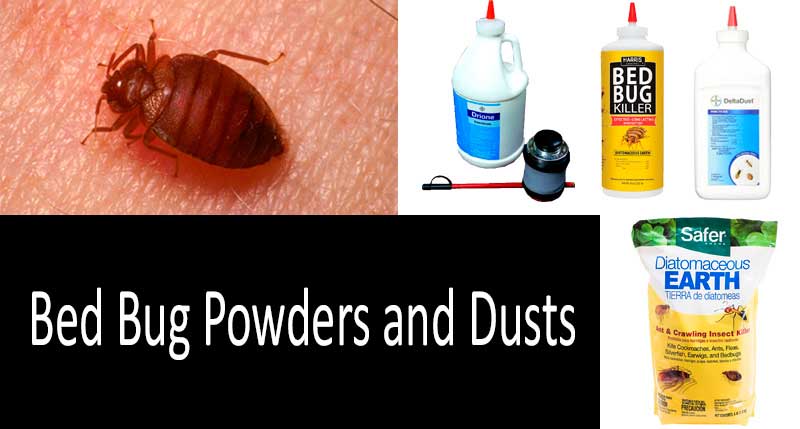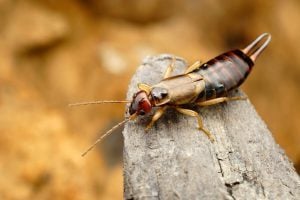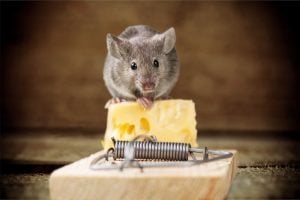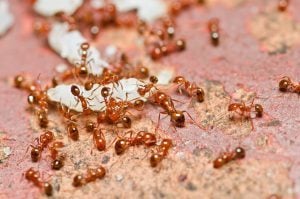Dusts are one of the most effective means of getting rid of bed bugs. When can they be better and more effective than sprays? We’ll figure out down to the tiniest detail which products are to be used and how to do this properly and at the end of the article, you will find a comparative review of the five best bed bug dusts & powders.
Table of Contents:
How Does it Work: What Do the Scientists Say
Dusts are handy when it is pointless or dangerous to use liquid insecticides. Powdery products have a long-lasting effect while liquids lose their properties after drying. Moreover, powders can be safer than many killer sprays.
As the University of Michigan experts explain, dusts are the best choice for treating cracks where bed bugs like to hide, such as behind headboards, along the bed frame, and under the baseboards.
How to apply dusts
If dust is applied in these areas, the bed bugs will become coated in the dust and won’t be able to escape. Dusts can be puffed in behind electrical outlets and switch plates and used in the empty spaces behind walls to catch bed bugs traveling from one room to another.
They will do not only for local treatment of cracks and crevices. You can also treat large territories with dusts as it is very cost-effective. The only drawback is that everything will be covered in dust and you will have to deal with mess for a while waiting for the results. Sprays, on the other hand, are cleaner and user-friendlier.
How Diatomaceous Earth Kills Bugs
Diatomaceous earth is made of diatomaceous algae fossils shredded to a flour-like state. As the University of Florida scientists explain, an insects’ chitinous cover is coated with a thin and waxy protective layer. Once diatomaceous earth comes in contact with said insects, it absorbs wax and damages the chitinous cover with its sharp particles. This leads to dehydration of insects and consequent death.
Diatomaceous earth acts quickly enough killing only those individuals with which it has come in direct contact. However, this treatment is absolutely useless against any insect pests in a damp environment as moist diatomaceous earth completely loses its properties.
Is it safe for humans and pets?
Yes. The product is safe for humans and pets unless it get into their eyes, lungs and other mucous membranes.

NB: Use proper diatomaceous earth! Texas A&M AgriLife Research and Extension Center specialists warn: “Look for DE for insect control – it is not the same product as diatomaceous earth used in swimming pool filters, which is dangerous to breathe.” We’ll give an example of such proper diatomaceous earth below in our review of the 5 best powders and dusts.
What is the Difference between Silica Gel and Diatomaceous Earth?
Widely retailed silica gel is also considered effective by scientists. This crystal substance can be shredded, if needed. It hits the insect, removes the protective wax layer and dehydrates the chitinous exoskeleton while accumulating. In this way, the impact of diatomaceous earth and silica gel on parasites are nearly identical. Both substances target a variety of pests.
As the same specialists from Texas comments, both of these dusts are low risk to humans, and work by desiccating, or drying out, bed bugs which come in contact with it. Silica aerogel is, in some studies, superior for this purpose. It is sold under various trade names including Tri-Die™ and CimeXa™.
However, there is an important difference between the two.
- Diatomaceous earth is an inert abrasive substance. 100% diatomaceous earth is more active than silica gel. Even if a treatment contains diatomaceous earth only, it will be sufficient for killing parasites.
- Silica gel is an inert non-abrasive substance that comes in granules, meaning that unlike diatomaceous earth, it doesn’t damage the actual chitinous cover. It is often combined with other insecticides like pyrethrins and pyrethroids.
How to Use Bed Bug Powder: 5 Rules
Such products are usually applied under the skirting boards, down the cracks, behind the sockets and in other inaccessible places. Determine the scale of infestation and identify all the places where insects have been seen as well as their routes (for instance, through sockets and wall voids). Then begin the operation.
- Prepare the room for treatment: pack any food and children’s clothes, and don’t let kids and pets inside. Vacuum clean the floor, furniture and carpets.
- Squeeze your bottle containing the dust or a manual powder duster; apply a thin layer of dust down the cracks and holes. You can also use a broad brush or a tampon for this. When carrying out the treatment, make sure you wear gloves and a mask. If using a powder duster seems more convenient, fill it only for two thirds in order not to clog its spout.
- Treat the bottom of the carpet, behind the skirting boards, closet walls, doors, sockets, places behind paintings and any other spots where insects can hide. Treat the inside of the furniture by applying dust through holes, armrests and edges. We recommend that you leave the diatomaceous earth for as long as possible. Two weeks will be ideal. Move on to point 4 after that.
- Wash any open spaces after treatment with water and soap. Vacuum clean the exterior of the furniture, floors and carpets. Wash your hands and face with soap. If your vacuum cleaner is equipped with bags, get rid of the used ones.
- Don’t despair if the insects are still visible after this clean-up. Just repeat the treatment.
When Powders Are More Effective Than Sprays
Dusts are more effective thanks to their long-lasting effect, which is essential when eliminating multiplying insects. Several weeks will be required for getting rid of bed bugs, including the individuals that will hatch later. Liquid insecticides cease to work once they dry up.
As we have mentioned above, dusts are great for use in cracks and inaccessible spaces, especially on furniture that should not be drenched. You can also use them if the infestation covers a large territory. The only issue is that it will create a lot of mess as the dust will be everywhere.
Comparative Chart of Bed Bug Powder and Spray Effectiveness
| Type | Advantages | Disadvantages | Best Use |
| Powder | Quick action Long-lasting effect (for up to 6-8 months). Cut-rate and cost-efficient Penetrates deep into any cracks. |
Loses its properties in moist environments (powder with deltamethrin does not) Causes a mess as everything will be covered in dust. |
Is convenient for treating both inaccessible places (behind the skirting boards, down the cracks) and large territories. |
| Spray | Is suitable for both local treatment, large territories and vast spaces. Has quick action. Is a user-friendly method. |
Dries and loses its killing properties quickly. | Treat bed, furniture, luggage and large territories if required. |
Find the best sprays in our review of 5 best bed bug killer sprays.
Top-3 Bed Bug Powders
Both pure dusts and dusts with added insecticides are sold. First, we will review three 100% organic products based on diatomaceous earth and silica gel. After that, we will take a separate look at two insecticides.
Diatomaceous Earth is sold in both large packs (Safer) and smaller bottles (Harris) with a convenient fine spout that allows spraying down the narrowest cracks. Which one is best for you? That will depend on the area of infestation. Go for a large pack if that area is large. Have the parasites just appeared? Then a small tube will do. Both products promise to kill larvae and adults within 48 hours.
Safer DE – For Large-Scale Infestations
A 4 lb Safer pack is a very popular and 100% natural product which you have often encountered in our reviews. It is used for getting rid of cockroaches, fleas, earwigs, silverfish, crickets, millipedes and centipedes. Its main advantage is that insects cannot develop a resistance to it since there are no chemicals to build immunity from. Read all customer reviews to learn more.
No convenient application devices are supplied, so you will have to make a separate investment for such a device. The good old Pest Pistol powder duster.
Safer (4lb): Check the current price
Harris DE – For Smaller-Scale Infestations
8 ounces of Harris Diatomaceous Earth Powder is available in a bottle with a narrow spout for convenient use. It has enough positive feedback on and a rating of 4 stars out of 5, The manufacturer claims that it acts for a few weeks as long as it is dry.
Harris (8 oz): Check the current price
Unlike diatomaceous earth, silica gel does not damage the chitinous cover. Instead, it sticks to the insect and thus dehydrates and kills it.
CimeXa Organic Insecticide
This insecticide consists of 100% amorphous silica gel and is more expensive than previous products. Just like diatomaceous earth, it targets a variety of pests: bed bugs, fleas, ticks, lice, roaches, ants, firebrats, silverfish, spiders, mites and drywood termites. It can be used both dry and dissolved in water for spraying. It is not yet very popular, but 75% of reviews are accompanied by the highest mark.
CimeXa: Check the current price
Why are Deltamethrin or Pyrethrins Added To Silica Gel-Based Dusts?
Some dusts are mixed with insecticides for enforcing and accelerating their lethal action:
- A dust combined with pyrethrins or pyrethroids has a dual action: physical (dehydration) and impact on the nervous system (it paralyses the insect), as the University of Michigan specialists observe.
- Deltamethrin (pyrethroid) allows a product to act even in an extremely damp environment as it is a waterproof active ingredient.
Precautions when using dusts containing insecticides
Unlike 100% natural diatomaceous earth and silica gel, such insecticides may be used only in non-food areas.
Delta Dust Multi Use Pest Control – Is Effective Even in Moist Environment
This dust supplied in a 1 lb tube has great reviews in comparison with similar products. Its target pest list includes 30 various species including many household and garden pests. Its active ingredient is 0.05 deltamethrin which lets it act even in moist environments. A single pound will cover an area of 2 000 square feet. According to the manufacturer, the killing effect is retained for up to eight months.
Delta Dust: Check the current price
Drione Pest Insecticide Dust – Dual Effect
Amorphous silica gel-based dust with pyrethrins by Drione has is highly regarded. It contains 1% pyrethrins and 40% silica gel. This combo-set includes a 1 lb tube with the actual substance and a duster. The product will deal not only with bed bugs, but also with ants, cockroaches and a dozen other pest insects. It promises that the long-lasting effect will last over 6 months.
The product can kill individual insects quickly enough, but removal of a full-scale invasion will take a couple of weeks. Read all the reviews to find more helpful tips about using Drione.
The manufacturer warns that Drione should not be used inside or around ventilation and heating. Don’t spray it inside an AC!
Drione (dust + powder duster): Check the current price
Best Bed Bug Powders and Dusts Comparative Chart
| Product | Active Ingredient | Action | Effectiveness | Price |
| Safer DE
|
DE | Damages the chitinous cover and causes death by dehydration. | Highly effective. Initial results will be visible within 48 hours if used properly in a dry place. | (4 lb) |
| Harris Diatomaceous Earth Powder
|
DE | Damages the chitinous cover and causes death by dehydration. | (8 oz) | |
| CimeXa
|
Silica gel | Causes death by dehydration. | Quick paralysing, slow killing. | (4 oz) |
| Delta Dust
|
Silica gel + deltamethrin | Paralyses and causes death by dehydration. | (1 lb) | |
| Drione
|
Silica gel + pyrethrins | Paralyses and causes death by dehydration. | (dust + powder duster) |
{code 135}
Which one from natural powders is stronger and more effective: DE or silica gel? And why?
While diatomaceous earth and other desiccants are recommended by the EPA as part of the integrated bed bug management and control, their effectiveness is still questionable when used alone. In the laboratory environment, diatomaceous earth has shown that it is, in fact, able to kill bed bugs when applied continuously in labeled amounts. However, some studies showed poor performance of DE when applied short-term or in smaller amounts.
The researchers from the University of Kentucky made a series of field trials to test the efficacy of diatomaceous earth which was used as a sole treatment. Unfortunately, the results were discouraging, showing that in some cases the bed bug population even increased. The scientists explained the DE poor performance by assuming that bed bugs’ ability to resist the desiccation was due to them being prone to retain moisture for a long time and replenishing their water reserves by consuming more blood.
These same researchers repeated the field tests by employing silica gel instead of DE, only this time, with amazing results: “abbreviated exposures (as brief as a few seconds) to barely visible deposits [of bed bugs] resulted in 100 percent mortality of adult bed bugs.”
So why the silica gel is more effective?
In fact, the researchers from the University of Kentucky, offer a very interesting explanation: the insecticides are often transported with the electronics to prevent moisture from accumulating around the packages during shipping. And since silica is comprised of tiny fluffy particles that come electrostatically charged, they stick to the insects’ shells much better and “absorb the cuticular waxes of insects onto the dust particles”, unlike DE, which acts as an abrasive.
And what’s wrong with DE?
The experiment which was conducted by the researchers from the University of Kentucky proved DE to be rather ineffective. Why? Because they decided to act as though the rooms were treated by regular consumers, do-it-yourselfers. The researchers purchased cosmetic and paint brushes from retail stores and applied a thin layer of DE across the furniture, or whenever they saw insects’ activity. Just as a regular consumer would have done.
This method, however, didn’t bring any positive results and was ruled out as completely ineffective. The reason behind this is that when applying DE, you’ll need to apply a relatively thick layer of powder to be effective. This brings us to a major disadvantage of DE since no one would be happy to see their room fully smeared and covered with insecticide powder. Also, in case you’re living in a humid climate, DE would be just as ineffective. Thus, silica beats DE in this battle.
As for the effectiveness of bed bug powders in comparison with other methods (sprays, traps, vacuuming, heating): None of them should be used alone because only a combination of methods will result in a successful treatment.
How long should the treatment with bed bug powders last?
According to theresearchers from the University of Kentucky, a single treatment with silica is enough to target the major population of bed bugs, however, a second and third thorough application would guarantee the efficacy of decreasing the population by 90%.
How long does bed bug powder take to kill?
DE is claimed to kill the bugs within 48 hours, but as the recent research has shown, it might not work at all if you apply it in a very thin layer. Silica will kill the bug within seconds if applied right on a bug and will stay potent for at least 12 weeks after application (continuing to kill the remaining population).
Does a bed bug powder kill bed bugs’ eggs?
Nope, you will have to use other methods to target eggs specifically or apply the powder after an initial treatment to target hatched up eggs.
Usage tips
-
Do not apply the powder all over your bedroom, you’ll just create a mess that will be hard to clean up
-
Apply the powder to crevices, cracks, along the seams of the mattress, baseboard, floor and headboards, along the walls, so there’s more chance the power will stick to the bug’s shell
-
Research has shown that silica gel is more effective when applied as a dust than an aqueous suspension
-
Apply the dust with a brush where puffing doesn’t seem like a viable option (seams, crevices, folds)
-
Use other methods (like sprays) and monitor the bed bug population using the bed bug traps (or monitors)
Bed bug powder for mattress
In case you’re looking for a specific recommendation that would surely kill all the bugs traveling around your mattress, then go for CimeXa (silica gel), it’s so potent, you’d be surprised.
Bed bug powder for carpet
Delta Dust from Bayer (silica gel + deltamethrin) should be applied with a cosmetic brush or a hand duster (any other suitable appliance, really) under and along the edges of the carpet. Apply it lightly and uniformly.
Bed bug powder safe for babies
None of the stuff is really safe for babies. However, most powders are claimed to be non-toxic and safe around pets and children, provided that none of your household members swallow or consume the powder by any other means, like licking. If you’re really that much concerned about the safety, then use Harris Bed Bug Powder with diatomaceous earth, which is considered as a somewhat natural alternative to other chemically-ridden pesticides. However, don’t get your hopes too high, since DE might not deliver as well as you might expect.
Precautions
According to the CDC, “factors that most frequently contributed to insecticide-related illness were excessive insecticide application (18%), failure to wash or change pesticide-treated bedding (16%), and inadequate notification of pesticide application (11%).”
That being said, it’s very important to follow the manufacturer’s instructions, and never overapply the powders.
Also, according to the EPA pool or food-grade diatomaceous earth can be harmful when you breathe it in. The pesticide version reduces the hazard by using a different size of diatoms.
Now, you’ll say, wait a minute, you’ve just recommended it for use around babies. And you’re right. We, in fact, did. But we talked about the DE that’s approved by the EPA. Harris items are all approved, so you don’t have to worry about that. This precaution concerns people who seldom purchase items from street vendors, garage sales, etc, because it’s important to find out if the product you’re about to use has been tested for safety and, of course, effectiveness.
Inhaling too much bed bug powder can result in nausea, diarrhea, headaches, dizziness, vomiting. In case that happens, please, call 911 immediately.
What is the most effective bed bug powder?
Anything that contains silica and which should not be diluted with water will be super potent at killing bed bugs. Our best bet is Delta Dust (Silica gel + deltamethrin).
Bed Bug Powders FAQ
Can you use flea powder to kill bed bugs?
Yes, you can, because such powder usually contains diatomaceous earth or silica gel. Both are effective against fleas and bed bugs.
Does baby powder kill bed bugs?
There is much irrelevant information about baby powder or talc on the Internet. Talc is said to repel bedbugs. Some conclude that baby powder can kill them just like silica gel. The scientists do not confirm this idea, but they note that baby powder can also be used against bed bugs as a supplementary treatment.
As Michael Merchant from Texas A&M AgriLife Extension Service clarifies, some devices, like the Climbup Interceptor, require redusting with a very small amount of talcum powder to make them slippery again and reduce the bed bug’s chance of escape. Note that talc is not toxic to bed bugs, but simply makes it harder for them to climb out of the cup. The talc should be barely visible, and more is definitely not better.
Can you get rid of bed bugs by using powders only?
No, getting rid of parasites requires a complex approach, meaning that a mattress cover should be used and washing clothes and cleaning of all the infected areas is required along with powder treatment. Your bed and mattress are the breeding ground for the bed bugs. Begin treatment with these places. We have systematized all the important tips in a single article. Read our guide about how to get rid of bed bugs.
{code 419}

















9 thoughts on “Bed Bug Powders and Dusts Review”
Even after we used the bedbug powder, I still see a few bed bugs daily. You’ve got to be patient, as it has cumulative effect instead of an instant one. Be generous and pour lots of this powder everywhere where bed bugs are or can be. Be careful, the powder only kills live insects, and has no impact on eggs.
I have a feeling that this powder for bed bugs works everywhere but in our bedroom. We poured it all over our bed, what’s next? I think we made them even madder as my boyfriend and I were terribly bitten last night. I’m calling the exterminators!
The powder that kills bed bugs works great! Before it I used a spray. I decided to experiment and stuck a couple of them in a jar which I sprayed inside. After two weeks the bloodsucker are still alive! As soon as I bought the powder, I poured it everywhere I could. Surprisingly, the bugs were gone in a couple of days. Another good thing is that it also kills flies and spiders!!
I think that Cimexa is the best bed bug killer powder. Just follow some rules when using this powder: first, dismount the bed and pour the bed and the floor with the powder by all means. Also, do not neglect the carpet. If you do this, you will 100% get rid of these creatures.
Today I arranged a home battle: cimexa insecticide dust vs diatomaceous earth. I was shocked by the results as I thought that diatomaceous earth would be defeated… But practice showed that it is a decent rival to the bed bug power. I think they both deserve five stars!
I genuinely don’t know what to say as I used not only powder to kill bed bugs, but also the spray, because when I used the powder alone, bed bugs were transmitted to the other room all the time until I started combining treatments.
Hi, can any of these dusts be gotten in Africa? particularly Nigeria?
Nice
Your giving delta dust a leg up was wrong, I have read before this and after reading and delta dust does not contain silica gel in any description or label listing, and it doesn’t work, after sprayin a chair that had bedbugs in it, they were riled at first then quited down next day for a while and then back to jumping again, in a report about silica gel and de, it was shown de ineffective and delta dust had lost the fight against newer strains, you also forgot that a good working combination in Tri-die because it was biased against a BASF product